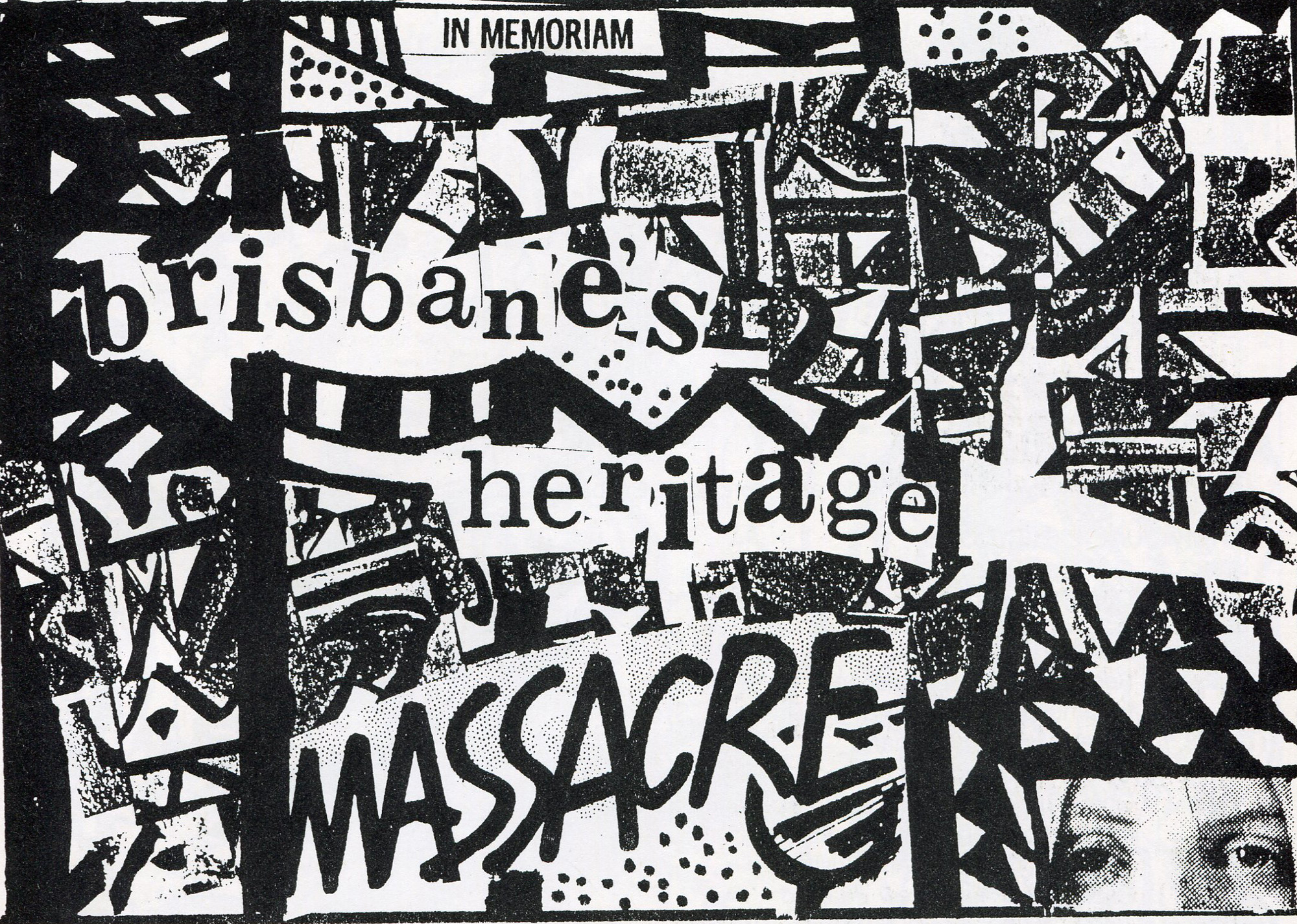Artist-Run Spaces Brisbane – Remembering That Collective + The Demolition Show
By Lindy Collins
After finishing at my studies in Visual Art at the QCA in 1980; then located at Seven Hills, I continued my learning at the Brisbane Institute of Art, which was then located in Fortitude Valley. I was also painting and exhibiting at small galleries. Teaching children’s art classes and doing a Graduate Diploma of Education. I spent a year as a first year teacher in Toowoomba and saved up enough money to travel for a year.
Having just returned from hitch hiking around Europe and living in the UK , it was good to be back living in New Farm. It was 1984 and as it happened my old flat in Moreton Street was still available and artists John Waller and Claude Le Compte lived next door at 105 Moreton Street.
I remember that the first meeting of artists for forming the collective for That Contemporary Art Space took place in John’s place and we tried lots of names for the space before deciding. The building we found was positioned behind the Pancake Manor in Charlotte Street , an old one level warehouse with a clerestory in what was an old light industrial area of Brisbane city and we marked out each of our studio spaces, around ten to twelve studios, with masking tape.
I chose the corner of the building as it had great light for drawing and painting. I found an old couch on the street and dragged it inside and spent hours being fallow on it.
For me as a young artist at the time, it was a creativity inferno with artists and musicians, people living in their studios and parties until morning. These artist-run meetings were really interesting and all decisions were made collectively. The studios were upstairs and the gallery downstairs. Youth gives immense courage and chutzpah.
My art making was eclectic and for economic reasons I made do with recycled things, being on the cusp of post modernism I managed to ignore Foucault and just made art as I have always done.
My studio area I marked off with long calico swathes hanging from the rafters to align to where the masking tape boundaries lined the measured studio area. I loved being part of an art collective of like-minded people who were passionate about art practice and we just got on. I can’t remember any grumpiness and people shared. Being a socialist it followed that working in a collective was the most logical way to go.
Artist John Stafford curated his first big exhibition with the Demolition Show in 1986, which I and many others were invited to participate in. It was at another artist-run space which started the the same year in 1985, The Observatory, also a collective of artists and located in the Little Roma Street precinct.
At this time whole streets of Georgian Brisbane were being demolished and the face of the city was becoming obliterated and modernised.
For this Demolition Show exhibition I did an installation of Buddhist prayer flags naming all the heritage buildings that had been demolished in the preceding five years.
I recall we were threatened with legal action if the flags were installed outside the gallery and went across the street as I had originally planned, so they had to go up the stair well inside The Observatory located in Little Roma Street instead, the actual gallery space was upstairs on the first floor.
I am a passionate environmentalist and care for heritage. I recall I also did a street art poster sticker run before The Demolition Show, at the time the Brisbane City Council had a Heritage Walk project taking place. They were sticking yellow stickers on the footpath in front of heritage buildings and gave people maps to show the last of the city’s heritage.
So we did the same type of thing for the Demolition Show with the yellow stickers but we called it the HERE IT WAS walk and went around town to all the demolished building sites of heritage such as the Bellevue Hotel in George Street and other desecrated sites, we adhered these stickers carefully – and designed them to look exactly like the council ones- and located them in front of many of these missing buildings. They stayed there for months.
Participating in THAT Collective was the defining time of my art practice as I was surrounded by extraordinary creative people who had no need for boundaries and their genius flourished, my own art making has sustained me since this time. I would have stayed twenty-five forever if I could have. However fifty five gives another sort of freedom.
The Institute of Modern Art had a travelling exhibition of contemporary Brisbane artists touring regional galleries about this time, 1986 from memory, and I had two paintings in the show. My art practice continued while teaching design and drawing at TAFE. The 80s decade was a time of great creativity, not having a car, riding everywhere on my bicycle, fabulous music, gallery openings, happenings, watching performance artist Stellarc fly across a warehouse suspended by meat hooks. Brisbane was just alive with art, the Fitzgerald Inquiry was completed in 1989 and the waves of talented people who fled the city in the 1970s and 1980s returned in time.




